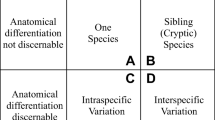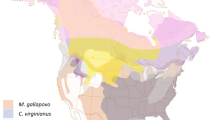Abstract
Osteological remains of small waders of the order Charadriiformes are regularly found in archaeological sites in Europe. Due to high taxonomic diversity, the rarity of some species in reference collections, and a lack of published diagnostic criteria, their identification poses challenges. To help resolve this issue, this study uses morphometric data, taken on a sample of extant wader skeletons, to identify metric criteria for species differentiation. Despite the relatively small sample size, the results show that multiple taxa can be distinguished using morphometrics. Used in conjunction with comparative morphological analysis, this morphometric method provides a valuable aid to zooarchaeologists working on wader remains from continental Northwestern Europe.









Similar content being viewed by others
Data availability
The author confirms that all the data supporting the findings in this study are available in the supplementary data.
References
Albarella U, Dobney K, Rowley-Conwy P (2009) Size and shape of the eurasian wild boar (Sus scrofa), with a view to the reconstruction of its Holocene history. Environ Archaeol 14(2):103–136
Albarella U, Baker P, Browaeys E, Corbino CA, Mulville J, Poland G, Worley F (2020) The archaeology of human-bird interactions: essays in Honour of Dale Serjeantson Part I. Quatern Int 543:1–7
Ballman P (1978) Knochenfunde Von Vogeln Aus Der Abeit Sankt Peters zu Gent, Belgien (VII Bis XVII Jahrhundert). Le Gerfaut 68:551–576
Barbosa A (1990) Identification key of Iberian waders (Charadriiformes) based on the Os Quadratum. Miscellaneous Zool 14:181–185
Bochenski ZM (2008) Identification of skeletal remains of closely related species: the pitfalls and solutions. J Archaeol Sci 35(5):1247–1250
Bochenski Z, Bochenski Z (1992) Correlation between the wing length of living birds and measurements of their bones. Belg J Zool 122(1):123–132
Buckley M, Kansa SW, Howard S, Campbell S, Thomas-Oates J, Collins M (2010) Distinguishing between archaeological sheep and goat bones using a single collagen peptide. J Archaeol Sci 37(1):13–20
Causey D (2005) Old bones in new boxes: osteology collections in the new millennium. Auk 122(3):971–979
Codlin MC, Douka K, Richter KK (2022) An application of zooms to identify archaeological avian fauna from Teotihuacan, Mexico. J Archaeol Sci 148:105692
Cohen A, Serjeantson D (1996) A manual for the identification of bird bones from archaeological sites. Archetype, London
Dalén L, Lagerholm VK, Nylander JAA, Barton N, Bochenski ZM, Tomek T, Rudling D, Ericson PGP, Irestedt M, Stewart JR (2017) Identifying Bird remains using ancient DNA barcoding. Genes 8(6):169
Dirrigl FJ, Brush T, Morales-Muñiz A, Bartosiewicz L (2020) Prehistoric and historical insights in avian zooarchaeology, taphonomy and ancient bird use. Archaeol Anthropol Sci 12:1–8
Eda M, Morimoto M, Mizuta T, Inoué T (2020) ZooMS for birds: discrimination of Japanese archaeological chickens and indigenous pheasants using collagen peptide fingerprinting. J Archaeol Science: Rep 34:102635
Ehrlich F, Rannamäe E, Valk H (2022) Bird exploitation in Viljandi (Estonia) from the Late Iron Age to the early modern period (c. 950–1700). Quatern Int 626:95–105
Fick OKW (1974) : Vergleichend morphologische Untersuchungen an Einzelknochen europäischer Taubenarten. LMU-München
Hong JH, Oh CS, Kim HI, Woo EJ, Cho TS, Shin DH (2020) Ancient mitochondrial DNA analysis of avian bones collected from the 4th century pit burial found in South Korea. Archaeol Res Asia 24:100214
Jaatinen K, Lehikoinen A, Lank DB (2010) Female-biased sex ratios and the proportion of cryptic male morphs of migrant juvenile ruffs (Philomachus pugnax) in Finland. Ornis Fennica 87(4):125–134
Jiguet E, Audevard A (2017) Birds of Europe, North Africa, and the Middle East. Princeton University Press, Princeton, New Jersey
Langer G (1980) Vergleichend morphologische Untersuchungen an Einzelknochen in Mitteleuropa vorkommender mittelgroßer Eulenarten. LMU-München
Martinez Sanchez RM, Valverde R, Moreno-García M, Maldonado Ruiz M, Granados Torres A, A., Delgado Huertas A (2020) Who let the dogs in? Lap dogs, canid sacrifices and funerary practices in the roman cemetery of Llanos Del Pretorio (Cordoba, Spain). Archaeol Anthropol Sci 12(87):1–17. https://doi.org/10.1007/s12520-020-01033-1
Natale R, Slater GJ (2022) The effects of foraging ecology and allometry on avian skull shape vary across levels of phylogeny. Am Nat 200(4):E174–E188
O’day SJ, Van Neer W, Ervynck A (2003) Behaviour behind bones: the zooarchaeology of ritual, religion, status and identity. Oxbow Books, Oxford
Pavia M (2020) Palaeoenvironmental reconstruction of the cradle of Humankind during the Plio-Pleistocene transition, inferred from the analysis of fossil birds from Member 2 of the hominin-bearing site of Kromdraai (Gauteng, South Africa). Q Sci Rev 248:106532
Potapova OR (1990) Bird remains from the Pleistocene deposits of Medvezhya Cave in the Northern Ural. Proceedings of the Zoological Institute Leningrad, 212, 135–153
Prassack KA, Pante MC, Njau JK, De La Torre I (2018) The paleoecology of pleistocene birds from Middle Bed II, at Olduvai Gorge, Tanzania, and the environmental context of the Oldowan-Acheulean transition. J Hum Evol 120:32–47
Schäfer F, Schmitz G (2016) Skull identification key for central European shorebirds (Aves: Charadriiformes: Scolopaci and Charadrii). Stuttgarter Beiträge Zur Naturkunde A 9(1):267–282
Sergeantson D (2009) Birds. Cambridge Manuals in Archaeology. Cambridge University Press, Cambridge
Serrano F, Costa-Pérez M, Navalón G, Martín-Serra A (2020) Morphological disparity of the Humerus in Modern Birds. Diversity 12:173
Stewart JR (2007) An evolutionary study of some archaeologically significant avian taxa in the Quaternary of the western Palaearctic. Br Archaeol Rep, 1–294
Stewart JR, Carrasquilla FH (1997) The identification of extant European bird remains: a review of the literature. Int J Osteoarchaeology 7(4):364–371
Svensson L, Grant P (2005) ANWB vogelgids Van Europa. Tirion, Utrecht
Székely T, Reynolds JD, Figuerola J (2000) Sexual size dimorphism in shorebirds, gulls, and alcids: the influence of sexual and natural selection. Evolution 54(4):1404–1413
Thys S, Van Neer W (2010) Bird remains from late medieval and postmedieval sites in Brussels, Belgium. Birds Archaeol Barkhuis Eelde, 71–86
Von Driesch D, A (1976) A guide to the measurement of animal bones from archaeological sites, vol 1. Peabody museum, Cambridge MA
Wang Y, Peters J, Barker G (2020) Morphological and metric criteria for identifying postcranial skeletal remains of modern and archaeological Caprinae and Antilopinae in the northeast Tibetan Plateau and adjacent areas. Int J Osteoarchaeology 30(4):492–506
Warinner C, Richter K, K., Collins MJ (2022) Paleoproteomics. Chem Rev 122(16):13401–13446
Weesie DM (1988) The quaternary avifauna of Crete. Greece Palaeovertebrata 18:1–94
Acknowledgements
I am grateful to Shijama Vermeersch, Bea de Cupere, Laura Llorente Rodriguez, Andre Ramcharan, Bram Langeveld, Pepijn Kamminga and Tarek Oueslati for granting access to the collections under their care. Veronique Laroulandie, Umberto Albarella and Phoebe Liu are thanked for sharing measurements of several specimens from the Universities of Bordeaux and Sheffield. I am indebted to Sophie de Bruijn for assisting me with the data collection.
Funding
The author did not receive any funding for conducting this study.
Author information
Authors and Affiliations
Contributions
The sole author of this manuscript is responsible for the conceptualization, methodology, formal analysis and investigation, writing and draft preparation, review and editing, and resources.
Corresponding author
Ethics declarations
Competing interests
The author does not have any relevant financial or non-financial interests to declare.
Additional information
Publisher’s Note
Springer Nature remains neutral with regard to jurisdictional claims in published maps and institutional affiliations.
Electronic supplementary material
Below is the link to the electronic supplementary material.
Rights and permissions
Springer Nature or its licensor (e.g. a society or other partner) holds exclusive rights to this article under a publishing agreement with the author(s) or other rightsholder(s); author self-archiving of the accepted manuscript version of this article is solely governed by the terms of such publishing agreement and applicable law.
About this article
Cite this article
Gruwier, B. Some morphometric criteria for the identification of small wader remains (Recurvirostridae, Haematopodidae, Charadriidae, Scolopacidae) from archaeological sites in continental Northwestern Europe. Archaeol Anthropol Sci 16, 98 (2024). https://doi.org/10.1007/s12520-024-02010-8
Received:
Accepted:
Published:
DOI: https://doi.org/10.1007/s12520-024-02010-8




